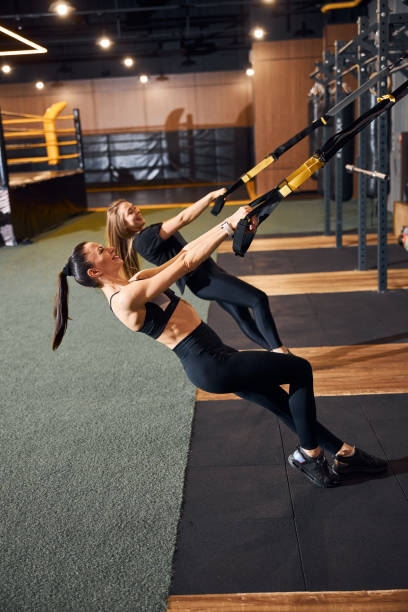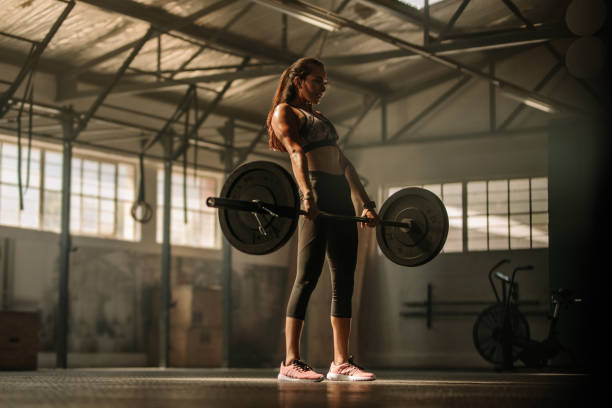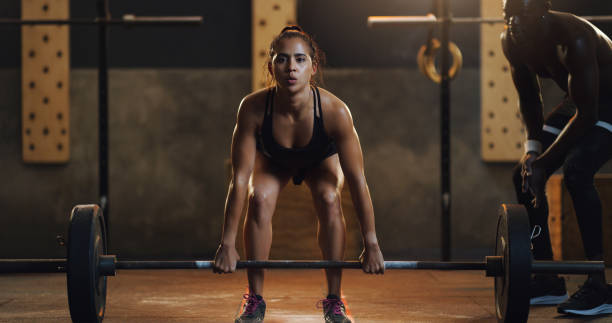Understanding Rack Pull and Deadlift

An in-depth look into perfecting your technique for rack pulls and deadlifts to build lower body strength and maximize gains. Read on to learn the importance of practicing proper form!
What Are Deadlifts? An Overview
Deadlifts are a type of barbell exercise popular among strength and weightlifters alike. This challenging compound movement targets the lower body muscles, including the glutes, hamstrings, quadriceps, and lower back.
Proper form and technique must ensure injury prevention and maximal results.
Deadlifts are generally performed beginning with the bar on the floor. The goal is to stand up straight while managing the weight from its starting position without using any momentum or hitching your hips/legs for additional height.
Maintaining good posture will reduce strain on other joints, such as the shoulders and knees, and maximize strength gains throughout these muscles because they must become strong enough to lift all that weight in one motion.
Deadlifts can also improve core stability when executed correctly; if done improperly, it can lead to low back muscular injury over time due to the heavy load placed upon this area during each repetition.
Defining Rack Pull: A Variation of Deadlift
A rack pull is a variation on the traditional deadlift exercise and can be a great addition to your workout regimen. In essence, this barbell-based exercise has similar benefits as its parent lift—it increases upper body strength while also activating your glutes, traps, and back muscles.
The key difference between a rack pull and a deadlift is that the former focuses solely on the top end of the range of motion. When performing these exercises, you set up with safety pins or racks at higher levels than in regular deadlifts.
Additionally, unlike full-range deadlifts, rack pulls are done from a partial range of motion in order to emphasize muscle groups like your upper back and trap more so than others.
Is a Rack Pull and Partial Deadlift The Same Thing?

No, a Rack Pull and a Partial Deadlift are not the same thing. In a partial deadlift, you bring the bar down to about knee height before returning up again, while in rack pulls, you use a squat rack that enables you to adjust the starting position of the weight higher than your knees.
This allows you to isolate certain muscles better, and there is less distance for the weights to travel compared to deadlifts, where they need to be lifted off from ground level and brought back down again.
Although both exercises target similar muscle groups — like glutes, quads, hamstrings, and erector spinae, among other key stabilizing muscles — rack pull focuses more on strengthening grip strength, which makes it an ideal accessory exercise for powerlifters or bodybuilders who want extra work on their grip strength while still targeting lower body muscle groups.
Are Block Pulls The Same As Rack Pulls?
No, Rack Pulls and Block Pulls are not the same. Although similar in purpose, they differ significantly in starting position and range of motion. Rack pulls begin with the bar being held on a squat rack at about mid-shin level, while block pulls are set up from an elevated platform around knee height to just below your waist – this creates a difference between where the muscles are worked.
For a longer range of motion closer to traditional deadlifts, rack pulls offer full bodywork as well as greater loading capacity compared to when done off the floor via deadlifts; however, due to their shorter range of motion block pulls can allow you to lift heavier weight than traditional deadlifts which can make them beneficial for building size and strength in certain muscle groups like quads, hamstrings, and glutes.
Ultimately, it’s important for each lifter to find what works best for them, whether focused primarily on varying between both types of exercises depending on their strength goal, each exercise depending on their training objectives, or alternating back and forth based upon their particular needs.
Comparing Rack Pull and Deadlift: Muscles Worked
Rack Pulls and Deadlifts target the same muscle groups in your body; however, their range of motion varies to target different muscles.
Rack Pull Muscles Worked: A Closer Look
When it comes to building strength and muscle, rack pulls are a great exercise. The primary muscles worked during this move are the glutes, lats, spinal erectors (smaller back muscles), and upper traps.
Secondary muscles that also receive work include the calves, hamstrings, and forearms. These muscular groups all help contribute to overall strength when working together for moves such as squats or deadlifts.
For example, strengthening your lats can make for more efficient shoulder positioning in the overhead press – aiding movement mechanics while engaging neglected areas of development with uni-directional compound exercises.
Rack Pulls vs. Deadlifts Muscles Worked: A Comparative Study

As a bodybuilder, understanding the specific muscles worked by rack pulls and deadlifts is essential for your training. These two exercises target similar, but not identical, muscle groups.
As you can see, both exercises work the quadriceps, glutes, and adductor magnus. However, deadlifts have a broader muscle engagement, targeting the hamstrings, erectors, and forearms.
While rack pulls are performed with the barbell at a higher position on the rack, they work fewer muscles compared to deadlifts, particularly in the lower body. This makes deadlifts more effective for building muscle and strength due to their greater muscle engagement.
Remember, conventional deadlifts are a more full-body exercise compared to rack pulls. Go ahead and choose the right exercise for your fitness goals.
The Benefits of Rack Pull and Deadlift
Both rack pulls and deadlifts offer multiple benefits, from improved lower body strength to greater conditioning for the entire body. Read on to discover all the pros and cons of these two exercises before trying them out yourself!
Benefits Of Rack Pulls vs. Deadlifts: Weighing the Pros

A rack pull is a variation of the deadlift, focusing on targeting specific muscle groups and improving overall strength. Deadlifts work more muscles than a rack pull, particularly in the lower body – making them great for increasing muscular size and strength.
Rack pulls target the lockout portion of the deadlift, allowing those training to place overload stress on this range of motion, which can help them quickly increase their overall power production ability.
Additionally, because there’s less forward flexion needed when performing rack pulls compared to conventional deadlifts, it can provide decreased stress placed upon your lower back.
Along with helping athletes target muscle groups, they wish to isolate or overload during training sessions, using rack pulls can also help you improve grip strength along with strengthening other areas required for effective barbell pressing movements, such as core stability and upper back musculature strength.
Rack Pull Benefits: Why Include Them in Your Routine?
Rack pulls are an essential exercise for any bodybuilder looking to get that extra boost in the gym. Unlike deadlifts, which are a standard compound movement for strength training, rack pulls target certain muscles more specifically and offer some unique advantages.
Adding rack pulls to your routine will help improve your pulling and grip strength while also decreasing stress on the lower back because of their limited range of motion. This exercise can also improve flexibility in the lats due to increased chest expansion as well as focus on lower-back stability so you can leg press heavier weights with confidence.
Ultimately, adding rack pulls into your program is an easy way to increase functional strength gains all around!
Common Mistakes and How to Avoid Them

It is important to be aware of improper form when performing rack pull and deadlift exercises, as incorrect technique can lead to injury. Common mistakes such as setting up with the bar away from the body and bouncing the weight off pins should both be avoided.
Common Rack Pull Mistakes: What to Watch Out For
- Not setting up with the bar away from the body: Setting up too close to the body can decrease the range of motion and limit the recruitment of certain muscles while increasing the risk of injuries. To prevent this, set up at a distance that allows for a full range of motion throughout the exercise without straining your form.
- Bouncing off the pins or blocks: Taking advantage of momentum by bouncing off safety pins or blocks decreases muscle recruitment and minimizes workload on targeted muscles, therefore reducing effectiveness in building strength as well as risking injury due to poor technique. So always keep your overall movements smooth and controlled during every rep, regardless of whether you are taking it easy or challenging yourself beyond your capabilities.
- Going too far down past knee height before coming back up: Performing rack pulls with a greater range than recommended (by going all the way down) increases the risk of spinal injuries due to compression forces on the lower lumbar area, so make sure you stop when reaching knee height before initiating upward movement in order to maximize its benefits without putting any stress upon your spine joints and discs.
Setting Up With The Bar Away From The Body: A Common Error
When performing rack pulls or deadlifts, one of the most important things to keep in mind is body positioning. Not keeping the bar close to your body can lead to short-term and long-term injuries.
The proper technique for both exercises involves having the barbell close to your body throughout the entire movement, as this helps create tension and stabilization on all working muscles while helping you maintain control over balance, power output, and range of motion.
A common mistake associated with setting up for the rack pull or deadlift is having the bar too far away from your body. This should be avoided at all costs, as it will reduce the overall engagement of correct form muscles and can result in inadequate contraction unless engaged properly – which often leads to imbalances, bad posture while executing lifts, unwanted stress in uninvolved areas of shoulders/back joints/hips & other repetitive joint pain especially when lifting heavy weights without proper technique.
Bouncing The Weight Off The Pins: Avoiding This Pitfall
When attempting a rack pull, it is important to maintain control of the weight throughout the entire exercise. Bouncing the weight off of the pins may seem tempting to those looking for a quick way to boost their max strength numbers, but in reality, missing out on this form cue can be detrimental to your training.
When you bounce off of the pins at any point during a rack pull, you not only decrease tension and time under tension for your muscles, but you also miss out on end-range activation, which can cause toning deficiency over time! Additionally, bouncing off of pins increases acceleration rather than torque, thereby relying more heavily on ligaments and tendons -which aren’t as strong or durable- when compared with predominately using muscle contractions (as they are meant to do).
This increases the risk of injury down the road. Therefore, if you’re doing rack pulls, then make sure that you keep all reps controlled with absolutely no bouncing so as not to defeat their purpose!
Form and Range of Motion
Perfecting your form during a deadlift is key, and understanding the difference between rack pulls and deadlifts will help you achieve this.
Deadlift Form: Perfecting Your Technique
It may sound simple, but deadlift form is one of the most fundamental aspects of strength training. Not only can poor technique lead to injuries, but being aware of how your body moves during a deadlift can also maximize the efficiency and effectiveness of the exercise for muscle growth.
The perfect deadlifting technique varies from person to person depending on flexibility muscle tissue activation capabilities, which depends on each individual’s level of physical preparedness for an actual set using proper rest periods between sets and reps; however, there are some key points that everyone should remember when performing this exercise.
These include keeping a neutral spine as you lift, engaging your core muscles with every rep, and maintaining good posture throughout the set by not allowing your shoulders to round forward or hunch back as you pull upwards.
You should also ensure that hands are placed in an optimal position; it needs to be wide enough so that you don’t collapse as you move into lockout but narrow enough that they maintain contact with the barbell throughout.
Programming Rack Pulls and Deadlifts

Learn how to strategically incorporate Rack Pulls and Deadlifts into your workout program for improved strength and optimal results. Read on to discover more!
How To Program Rack Pulls and Deadlifts? A Step-by-Step Guide
Programming rack pulls and deadlifts is an essential part of any bodybuilding program. As two of the most important multi-joint posterior chain exercises, incorporating both movements into your routine can help build total-body strength and power. Here are some tips for programming rack pulls and deadlifts to maximize their benefits:
Use Deadlifts as a Primary Compound Movement
Deadlifts are a powerful compound exercise that targets a number of major muscle groups in the legs, including the glutes and spinal erectors. When performed correctly, they can also help to engage your core muscles for greater stabilization, stability, and strength.
In addition to being incredibly effective for developing lower body strength and power, deadlifts are one of the most popular exercises used by strength athletes because they also activate multiple upper body muscles when executed properly — making them an ideal primary compound movement.
This means incorporating deadlifts into your routine will lead to improved total-body performance as compared to other single-joint exercises (like curls). As bodybuilders, our main goal should be to optimize muscle growth and increase lower body athleticism; plus, deadlifts provide both these qualities in spades! With strong activation of the all-important posterior chain, including hamstrings and glutes, which play huge roles in sports performance — you can’t deny their usefulness from a functional perspective either.
Program Rack Pulls to Improve Grip Strength
Rack pulls can be an incredibly useful exercise for bodybuilders looking to increase their overall pulling strength and grip strength. For those not familiar with rack pulls, they are a variation of the traditional deadlift in which the weight is lifted only partway off the floor.
This allows for greater focus on certain areas, such as grip development, while providing a range of motion that may be safer than pulling from the floor. Including regular rack pull sessions in your training regimen can have a dramatic effect on your overall performance.
As you might expect when performing any type of weighted exercise, this will allow you to lift more weight through improved form and increased muscle control due to greater stability in multiple joints.
Final Thoughts and Expert Advice
Both rack pulls and deadlifts have unique benefits, so it’s important to evaluate individual goals when deciding which is right for you. With safe form and the right program setup, both exercises can be a powerful tools for building strength and mass.
Use the Rack Pull to Build Mass: Expert Tips
The rack pull is gaining favor with bodybuilders as a way to build mass. It’s considered a partial deadlift, where the range of motion is shorter, allowing you to lift more weight than if you were doing the full-range deadlift.
To do rack pulls, set up in a squat rack and add plates to the barbell just below your knees. As with any exercise for muscle growth or strength gains, proper form is key when performing this variation of the deadlift.
Make sure your feet are positioned hip-width apart—this will help you stack your shoulders over your hips, which helps keep a neutral spine. Drive through your heels so that power comes from the ground up rather than pushing down into it.
Additionally, use an alternate grip during reps, such as switching hands with each rep for even stronger muscle growth results while avoiding placing too much strain on one side of the body compared to other rival exercises like squats or bent-over rows!
Are Rack Pulls For Strength or Mass? Understanding the Benefits

Rack pulls are great for training grip strength and pulling power, making them ideal for bodybuilders looking to increase their upper body strength and muscle mass. They can be used as a powerful accessory exercise to supplement traditional barbell deadlifts, targeting the lats, traps, forearms, and other muscles involved in pulling movements.
That said, it’s important to note that rack pulls focus more on heavier weights and lower volumes compared to total-body exercises like deadlifts or squats, which provide greater benefits when done with higher reps.
When performing rack pulls, you should ensure your back stays tight throughout the range of motion by keeping an arch in your spine while driving through your hips – this will help prevent any lower back strain caused by over-stretching muscles or ligaments.
Wrapping Up: Rack Pull vs Deadlift: Pros, Cons, Differences, & How-To.
Rack Pulls and Deadlifts are two of the most popular strength training exercises available to bodybuilders. While both involve working almost the same set of muscles, there are big differences between them that can make a significant impact on your progress in the gym.
For this reason, it’s important to understand the key differences between rack pulls and deadlifts so you can select an exercise that best meets your needs.
Rack Pulls require less range of motion than Deadlifts since you start with the bar higher off the ground. This allows for heavier weights, which enables greater muscle recruitment overall thanks to increased load – thus resulting in improved pulling power when compared directly against traditional Deadlifts.


Leave a Reply